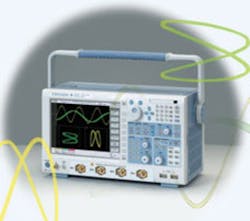The enthusiasm exuded by the company about the significance of this new scope meant that a visit to the home office with a side trip to the manufacturing plant was the only way for us to thoroughly understand and appreciate the importance of this introduction. So with passport in hand, I, along with four other editors from Europe and the United States, headed off to visit Yokogawa in Japan.
The company, formed in 1915, comprises six business units: Communications and Measurement, ATE, Industrial Automation, Industrial Solutions, Aerospace Products, and Sourcing and Manufacturing. Headquartered in Tokyo, Yokogawa Electric employs 18,675 people worldwide, operates in 28 countries, and has sales of approximately $4B. The design and development of digital oscilloscopes as well as other test instruments are the responsibility of the Communications & Measurement Business Unit.
With an emphasis on providing high-performance waveform display and analysis in a compact and lightweight instrument, this month Yokogawa is introducing the signalXplorer DL 9000 Series Digital Scopes. There are four scopes in the series: the DL9140 and DL9140L with a 1-GHz bandwidth and a maximum sampling rate of 2.5 GS/s on all four channels and the DL9240 and DL9240L sporting a bandwidth of 1.5 GHz at a maximum sampling rate of 5 GS/s on four channels (10 GS/s on two channels). The DL 9140 and DL 9240 provide a maximum of 2.5M of memory on each of the four channels; the DL 9140L and DL 9240L top out at 6.25M.
Besides the 1.5-GHz bandwidth capability of the series, the Yokogawa designers placed special emphasis on the waveform acquisition system. The result was a new acquisition system that featured acquisition speed uncompromised during multichannel operation, memory settings scalable while maintaining fast acquisition speeds, and real-time statistical representation of the waveform.
To maintain acquisition speed, the conversion section has cascade-type 2.5-GS/s 8-b ADCs running in parallel. This parallel processing architecture means the input signal on each channel is processed independently of the others. Acquisition speed will not be degraded during multichannel operation.
For signal processing, Yokogawa developed a proprietary ASIC called advanced data stream engine (ADSE). The IC enables memory-length flexibility while still achieving fast acquisition rates. Typically, fast acquisition rates necessitate small memory lengths. ADSE allows the use of as much or as little memory as necessary for a given measurement.
The user has the flexibility to configure the acquisition function to make meaningful measurements. For four-channel operation, the maximum acquisition rates for different memory settings for the series are 16,500 acquisitions/s for 2.5k points/acquisition, 9,000 for 12.5k, 900 for 125k, and 60 acquisitions/s for 1.25M points/acquisition. When using four channels, the scope can acquire a maximum of 450M points/s.
Other functions include an accumulation mode and a history mode. When the accumulation mode is turned on, the scope superimposes, in real time, images of all waveforms that have been saved in the history memory. Since the history memory is a FIFO system, only the most recent waveforms are stored and displayed.
Another selectable feature of the accumulation mode is pixel intensification where the brightness of a pixel is based on the number of times that pixel is activated by successive waveforms. Where waveform events occur more frequently, the pixels will be brighter, and conversely, where waveform events occur less frequently, the pixels will be dimmer. This is designed to provide intuitive information about the behavior of the waveform as it changes over time.
The DL 9000 scopes weigh about 15 lb, measure approximately 14″ • 8″ • 7″, and are rack mountable. For enhanced viewing, the display is an 8.4″ XGA high-resolution LCD. Scopes: from $10,995; 2.5-GHz active probe: $1,995.
FOR MORE INFORMATION
on the DL 9000 Series
www.rsleads.com/504ee-201

